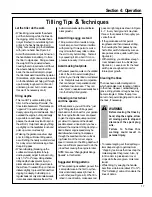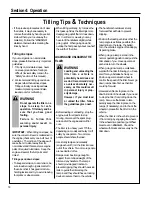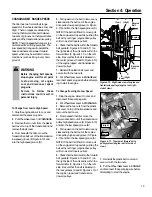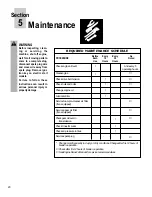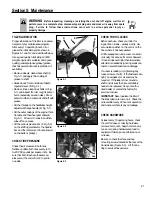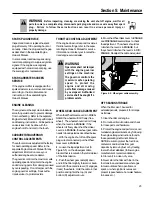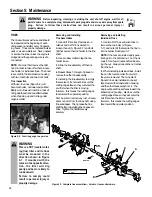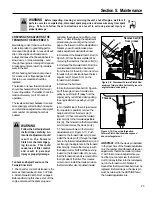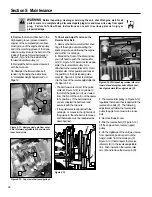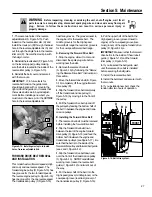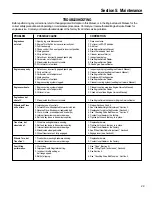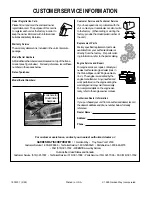
17
Section 4: Operation
Tilling Tips
&
Techniques
Let the tiller do the work
• While tilling, relax and let the wheels
pull the tiller along while the tines do
the digging. Walk on the side that is
not yet finished (to avoid making foot-
prints in the freshly tilled soil) and
lightly, but securely grip the handlebar
with just one hand. See Figure 4-2.
• Avoid the temptation to push down on
the handlebars in an attempt to force
the tiller to dig deeper. Doing so takes
the weight off the powered wheels,
causing them to lose traction. Without
the wheels helping to hold the tiller
back, the tines will attempt to propel
the tiller backward toward the operator.
(Sometimes, slight downward pressure
on the handlebars will help get through
a particularly tough section of sod or
unbroken ground, but in most cases
this won’t be necessary at all.)
Tilling depths
• This is a CRT (counter-rotating tine)
tiller. As the wheels pull forward, the
tines rotate backward. This creates an
“uppercut” tine action which digs
deeply, uprooting soil and weeds. Don’t
overload the engine, but dig as deeply
as possible on each pass. On later
passes, the wheels may tend to spin in
the soft dirt. Help them along by lifting
up slightly on the handlebar (one hand,
palm up, works most easily).
• Watering the garden area a few days
prior to tilling will make tilling easier,
as will letting the newly worked soil set
for a day or two before making a final,
deep tilling pass.
• When cultivating (breaking up the
surface soil around plants to help
destroy weeds), adjust the tines to dig
only 1-1/2" to 2" deep. Using shallow
tilling depths helps prevent injury to
plants whose roots often grow close to
the surface. If needed, lift up on the han-
dlebars slightly to prevent the tines from
digging too deeply. Cultivating on a
regular basis not only eliminates weeds,
it also loosens and aerates the soil for
better moisture absorption and faster
plant growth.)
Avoid tilling soggy, wet soil
• Tilling wet soil often results in large,
hard clumps of soil that can interfere
with planting. If time permits, wait a
day or two after heavy rains to allow
the soil to dry before tilling. Test soil
by squeezing it into a ball. If it com-
presses too easily, it is too wet to till.
Avoid making footprints
• Whenever possible, walk on the untilled
side of the unit to avoid making foot-
prints in your freshly tilled or cultivated
soil. Footprints cause soil compaction
that can hamper root penetration and
contribute to soil erosion. They can
also “plant” unwanted weed seeds back
into the freshly tilled ground.
Choosing correct wheel
and tine speeds
With experience, you will find the “just
right” tilling depth and tilling speed
combination that is best for your garden.
Set the engine throttle lever at a speed
to give the engine adequate power and
yet allow it to operate at the slowest
possible speed...at least until you have
achieved the maximum tilling depth you
desire. Faster engine speeds may be
desirable when making final passes
through the seedbed or when cultivat-
ing. Selection of the correct engine
speed, in relation to the tilling depth, will
ensure a sufficient power level to do the
job without causing the engine to labor.
NOTE: Also see “Changing Belt Range
Speeds” in this Section.
Suggested tilling patterns
• When preparing a seedbed, go over the
same path twice in the first row, then
make individual passes right next to
each other (see Figure 4-6). When fin-
ished in one direction, make a second
pass at a right angle as shown in Figure
4-7. In very hard ground it may take
three or four passes to thoroughly pul-
verize the soil.
• If the garden size will not permit
lengthwise and then crosswise tilling,
then overlap the first passes by one-
half a tiller width, followed by succes-
sive passes at one-quarter width (see
Figure 4-8).
• With planning, you can allow enough
room between rows to cultivate (see
Figure 4-9). Leave room for the hood
width, plus enough extra room for
future plant growth.
Clearing the tines
The tines have a self-clearing action
which eliminates most tangling of debris
in the tines. However, occasionally dry
grass, stringy stalks or tough vines may
become tangled. Follow these proce-
dures to help avoid tangling and to clean
the tines, if necessary.
• To reduce tangling, set the depth regu-
lator deep enough to get maximum
“chopping” action as the tines chop the
material against the ground. Also, try
to till under crop residues or cover
crops while they are green, moist and
tender.
• While tilling, try swaying the handle-
bars from side to side (about 6" to 12").
This “fishtailing” action often clears the
tines of debris.
WARNING
Before clearing the tines by
hand, stop the engine, allow
all moving parts to stop and
disconnect the spark plug
wire.
Failure to follow this
warning could result in
personal injury.
Содержание 12194
Страница 31: ...31 NOTES...
Страница 33: ...33...















